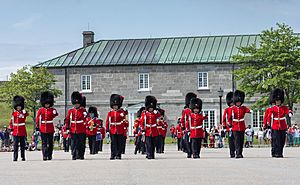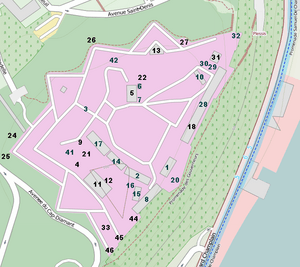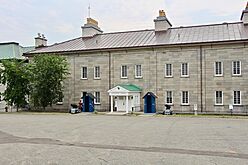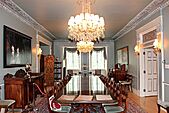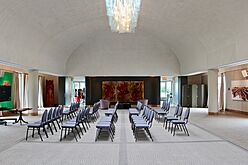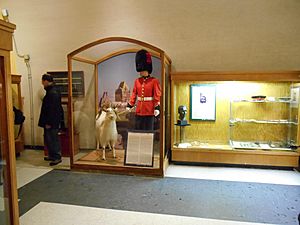Citadelle of Quebec facts for kids
Quick facts for kids Citadelle of Quebec |
|
|---|---|
|
La Citadelle de Québec (French)
|
|
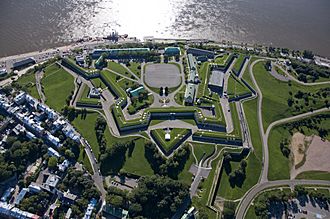 |
|
| General information | |
| Location | Quebec City, Quebec, Canada |
| Coordinates | 46°48′27″N 71°12′26″W / 46.8074°N 71.2071°W |
| Construction started | 1820 to 1850 |
| Cost | 200 000 sterling pounds, 60 000 estimated in 1816 |
| Client |
|
| Owner | The King in Right of Canada (Charles III) |
| Design and construction | |
| Architect | Various |
| Engineer | 9 |
| Official name: Québec Citadel National Historic Site of Canada | |
| Designated: | 15 May 1946 |
The Citadelle of Quebec (French: Citadelle de Québec), also known as La Citadelle, is a special place in Quebec City, Canada. It's an active military installation, which means soldiers still use it. It's also one of the official homes for the governor general of Canada, who is the King's representative in Canada. Sometimes, the King of Canada also stays here when visiting Quebec.
The Citadelle sits high up on a hill called Cap Diamant, right next to the Plains of Abraham. It's part of the old walls that protect Quebec City. Did you know Quebec City is one of only two cities in North America that still has its original city walls? The other is Campeche in Mexico!
People realized how important Cap Diamant was for defense way back in 1608. Over the years, both the French and then the British built defenses there. The Citadelle you see today was built between 1820 and 1850. The British wanted to protect Quebec City from possible attacks, especially from the Americans. The British used the Citadelle until 1871, when they gave it to the Canadian government. Since then, the Canadian Armed Forces have used it, and it has continued to be a home for the King's representatives.
The Citadelle is a very important historical site in Canada. It's part of the larger Fortifications of Québec National Historic Site. The whole area, called the Historic District of Old Québec, became a World Heritage Site in 1985. About 200,000 people visit the Citadelle every year!
Contents
A Look Back: The Citadelle's Story
The high ground of Cap Diamant was recognized as a great spot for defense by Samuel de Champlain in 1608. This led him to start Quebec City right at the bottom of the hill. The hill was so steep that the only side of the settlement that needed strong walls was the west, as the other sides were naturally protected.
First Walls and Defenses
French Beginnings
The very first protective wall was built in 1690, just in time for a battle in Quebec. Three years later, a plan for a new, wider wall was approved by King Louis XIV of France.
Building a full fort was thought to be too expensive by the French government, even though Quebec City was very important and also easy to attack. After a place called Louisbourg fell in 1745, a lot of work was done on the city's defenses.
British Take Over
After the British took over Quebec City in 1760, the first British governor, General James Murray, saw how weak the city's defenses were. He wanted a strong fort built, but the British government also thought it was too expensive. So, a smaller, wooden fort was built instead.
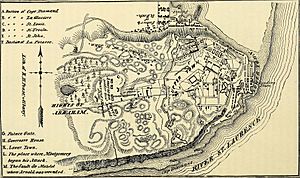
During the American Revolutionary War, American rebels tried to capture Quebec City in December 1775. They failed and had to retreat. The Americans tried to keep the city surrounded, but they left when British soldiers arrived in the spring of 1776.
The Citadelle We See Today
As tensions grew between the United Kingdom and the United States in the late 1700s, the British decided to make their colonies' defenses stronger. Walls were built around the Upper Town cliff, and four round towers (called martello towers, which you can still see today) were built on the Plains of Abraham before 1812. A large fort was planned, but again, it was considered too expensive.
This idea changed after the War of 1812. As part of a bigger plan to improve Canada's defenses, the current star-shaped fort was built between 1820 and 1850. It was meant to protect Quebec City from the Americans and to be a safe place for the British soldiers if there was an attack or rebellion. The Citadelle included parts of the old French walls from 1745. It was designed to store weapons, supplies, and to house soldiers. More buildings were finished in 1850.
After Canada became its own country in 1867, it became responsible for its own defense. The British left the Citadelle in 1871. Two groups of Canadian artillery soldiers were stationed there, and a school for artillery was opened in 1871, followed by a cavalry school. Over time, living conditions for soldiers at the fort got better.
The preservation of many of Quebec's old defenses is thanks to Governor General of Canada the Marquess of Dufferin and Ava. He also made the Citadelle an official home for the governor general in 1872, continuing a tradition that started long ago. Since 1920, the Citadelle has been the home base for the Royal 22e Régiment of the Canadian Forces.
Important meetings called the Quebec Conferences happened at the Citadelle in 1943 and 1944. During these meetings, leaders like Canadian Prime Minister William Lyon Mackenzie King, British Prime Minister Winston Churchill, and US President Franklin D. Roosevelt discussed plans for World War II.
The Citadelle was named a national historic site in 1946. In 1980, it was officially recognized as a National Historic Site of Canada. Five years later, the Historic District of Old Québec, which includes the Citadelle, was added to UNESCO's list of World Heritage Sites.
What the Citadelle Does Today
The Citadelle is still an active military installation for the Canadian Armed Forces. It's also an official residence for both Canada's King and its governor general. The governor general usually stays there for several weeks in the summer and at other times during the year. Just like at Rideau Hall in Ottawa, important ceremonies like giving out Canadian awards and welcoming new ambassadors happen at the Citadelle.
The residence is also open to the public. You can take free tours of the state rooms throughout the year. About 200,000 people visit the Citadelle each year.
Building 1 at the Citadelle is used as the main office for the Royal 22e Régiment. Many military ceremonies for the regiment also happen on the Citadelle's parade ground, like the changing of the guard and the special ceremony for their mascot, Batisse the Goat.
A cannon is fired from the fort every day at noon. This is a time signal that can be heard all over Quebec City. This tradition has continued since 1871, except for a period between 1994 and 2008.
Buildings Inside the Citadelle
The fort is shaped like an uneven star and has four strong points (called bastions) and three straight walls. All of these are built from local sandstone. Inside its walls, there are 24 buildings, mostly made of grey stone.
The Official Residence
The Officer's Barracks, a building built in 1831 by the British Army, has been the home of the governor general of Canada since 1872. Today, this residence has 153 rooms and covers a large area. It also includes offices for the governor general's staff.
The main entrance to the original part of the residence has double doors under a porch. Above the doors, you can see the words "GOUVERNEUR GÉNÉRAL" and the Canadian Coat of Arms. Inside, there's a fancy entrance hall with marble floors.
Soon after the building became a royal residence, more rooms were needed for the governor general's guests and staff, including a ballroom and a sunroom. However, these parts were destroyed by a fire in 1976. The rest of the residence was also damaged by smoke and water. The original part of the building was repaired, and new state rooms were built where the lost additions used to be. This work was finished in 1984.
This new part of the building was built at a slight angle to the 1831 structure. It has a copper roof and stone walls, just like the other buildings. This new section has its own entrance with two spiral staircases leading up to a main floor. On this upper level, there's a large event space, a lounge, and a sunroom with a terrace that looks out over the St. Lawrence River. The inside of the new addition was designed by a Quebec artist named Madeleine Arbour. She was inspired by the colors of winter in Quebec and used Canadian materials like granite and walnut. The residence is filled with furniture from the Crown Collection, including old pieces and modern Canadian art.
Royal 22e Régiment Museum
Building 15, built in 1750, used to be a powder magazine. Now, it houses the Museum of the Royal 22e Régiment and the Canadian Forces Museum. This museum collects and displays items important to Canadian military history, including weapons, uniforms, and other military artifacts of the Royal 22e Régiment.
Other Important Buildings
- Building 1: This used to be the Hospital Administration Building. It's a two-story stone building with a sloped roof and two chimneys. It has decorative pillars on the front.
- Building 2: Also known as the Men's Barracks, this building used to be an armory and powder magazine. It's a long, two-story stone building with a copper roof.
- Building 5: This was another Powder Magazine. It's a low, rectangular stone building with a sloped roof and a protective blast wall around it.
- Building 7: This is called the Memorial Building and is part of a group of three buildings near the parade ground. It has a stone roof. Governor General Georges Vanier and his wife Pauline Vanier are buried here in the chapel.
- Building 10: Located next to the governor general's residence, this building used to be a military prison and is now part of the museum. It was built in 1842.
- Building 14: This building, which used to store military supplies, stands along the parade ground. It's a long, two-story stone building with a copper roof.
- Building 16: This building is now the museum office and used to be a cooperage (where barrels were made).
- Building 17: Also known as the Men's Barracks, this two-story stone building is on the south side of the parade ground.
- Building 20: This building, called the Ball House, used to be an observatory and a time ball tower. It's a tall stone structure with different shapes.
- Building 32: This was the Defensive Guard House. It's a small, one-story stone building with a sloped roof.
- Building 46: This building, called the caponier, is mostly hidden within the walls. It's a small stone building with a small turret on its roof.
See also
- Government Houses in Canada
- Government Houses of the British Empire and Commonwealth
- List of forts
- Ramparts of Quebec City



